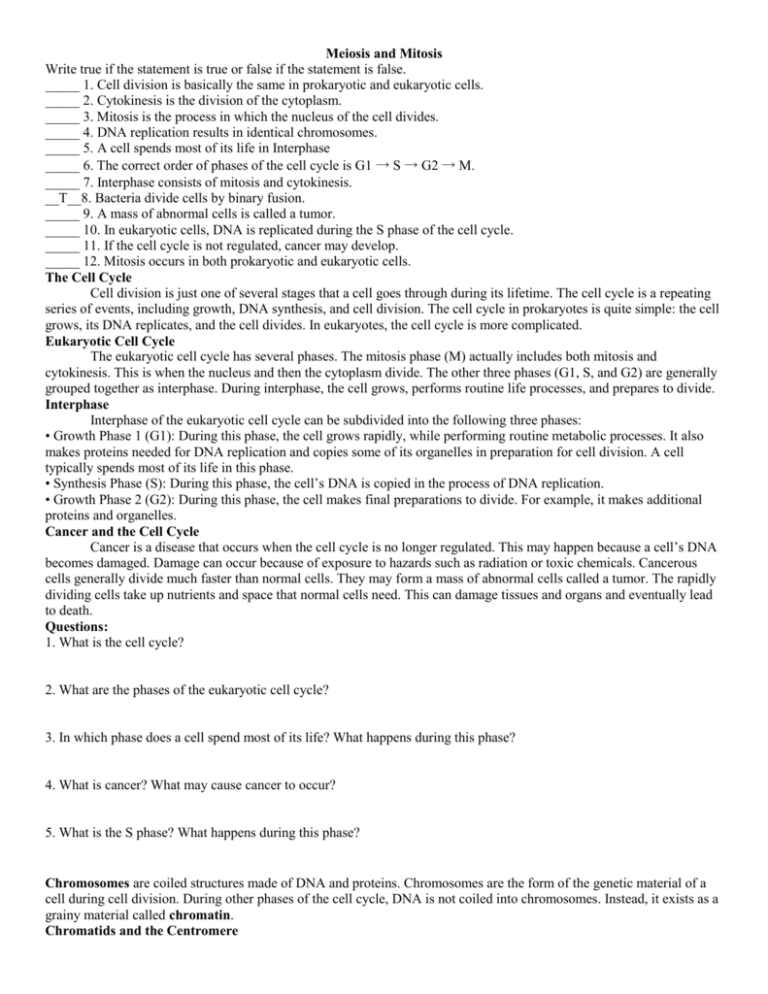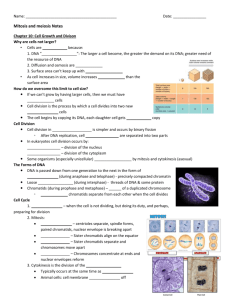File
advertisement

Meiosis and Mitosis Write true if the statement is true or false if the statement is false. _____ 1. Cell division is basically the same in prokaryotic and eukaryotic cells. _____ 2. Cytokinesis is the division of the cytoplasm. _____ 3. Mitosis is the process in which the nucleus of the cell divides. _____ 4. DNA replication results in identical chromosomes. _____ 5. A cell spends most of its life in Interphase _____ 6. The correct order of phases of the cell cycle is G1 → S → G2 → M. _____ 7. Interphase consists of mitosis and cytokinesis. __T__8. Bacteria divide cells by binary fusion. _____ 9. A mass of abnormal cells is called a tumor. _____ 10. In eukaryotic cells, DNA is replicated during the S phase of the cell cycle. _____ 11. If the cell cycle is not regulated, cancer may develop. _____ 12. Mitosis occurs in both prokaryotic and eukaryotic cells. The Cell Cycle Cell division is just one of several stages that a cell goes through during its lifetime. The cell cycle is a repeating series of events, including growth, DNA synthesis, and cell division. The cell cycle in prokaryotes is quite simple: the cell grows, its DNA replicates, and the cell divides. In eukaryotes, the cell cycle is more complicated. Eukaryotic Cell Cycle The eukaryotic cell cycle has several phases. The mitosis phase (M) actually includes both mitosis and cytokinesis. This is when the nucleus and then the cytoplasm divide. The other three phases (G1, S, and G2) are generally grouped together as interphase. During interphase, the cell grows, performs routine life processes, and prepares to divide. Interphase Interphase of the eukaryotic cell cycle can be subdivided into the following three phases: • Growth Phase 1 (G1): During this phase, the cell grows rapidly, while performing routine metabolic processes. It also makes proteins needed for DNA replication and copies some of its organelles in preparation for cell division. A cell typically spends most of its life in this phase. • Synthesis Phase (S): During this phase, the cell’s DNA is copied in the process of DNA replication. • Growth Phase 2 (G2): During this phase, the cell makes final preparations to divide. For example, it makes additional proteins and organelles. Cancer and the Cell Cycle Cancer is a disease that occurs when the cell cycle is no longer regulated. This may happen because a cell’s DNA becomes damaged. Damage can occur because of exposure to hazards such as radiation or toxic chemicals. Cancerous cells generally divide much faster than normal cells. They may form a mass of abnormal cells called a tumor. The rapidly dividing cells take up nutrients and space that normal cells need. This can damage tissues and organs and eventually lead to death. Questions: 1. What is the cell cycle? 2. What are the phases of the eukaryotic cell cycle? 3. In which phase does a cell spend most of its life? What happens during this phase? 4. What is cancer? What may cause cancer to occur? 5. What is the S phase? What happens during this phase? Chromosomes are coiled structures made of DNA and proteins. Chromosomes are the form of the genetic material of a cell during cell division. During other phases of the cell cycle, DNA is not coiled into chromosomes. Instead, it exists as a grainy material called chromatin. Chromatids and the Centromere DNA condenses and coils into the familiar X-shaped form of a chromosome only after it has replicated. Because DNA has already replicated, each chromosome actually consists of two identical copies. The two copies are called sister chromatids. They are attached to one another at a region called the centromere. Chromosomes and Genes The DNA of a chromosome is encoded with genetic instructions for making proteins. These instructions are organized into units called genes. Most genes contain the instructions for a single protein. There may be hundreds or even thousands of genes on a single chromosome. Human Chromosomes Human cells normally have two sets of chromosomes, one set inherited from each parent. There are 23 chromosomes in each set, for a total of 46 chromosomes per cell. Each chromosome in one set is matched by a chromosome of the same type in the other set, so there are actually 23 pairs of chromosomes per cell. Each pair consists of chromosomes of the same size and shape that also contain the same genes. The chromosomes in a pair are known as homologous chromosomes. Questions 1. What is a chromosome? What is it made out of? 2. What are homologous chromosomes? How many homologous pairs are in a human cell? 3. What is the main difference between chromatin and chromosomes? 4. Why do chromosomes look like an “X”? 5. What is a gene? Match the word with the definition: Definitions _____ 1. division of the nucleus _____ 2. region of the chromosome where sister chromatids are attached _____ 3. division of the cytoplasm _____ 4. phase of mitosis in which spindle fibers attach to the centromere of each pair of sister chromatids _____ 5. coiled structures made of DNA and proteins _____ 6. phase of mitosis in which sister chromatids separate and the centromeres divide _____ 7. a segment of DNA with the genetic instructions to make a protein _____ 8. two copies of replicated DNA that make a chromosome _____ 9. the first and longest phase of mitosis _____ 10. uncoiled DNA _____ 11. a pair of the same chromosome _____ 12. phase of mitosis in which the chromosomes begin to uncoil and form chromatin Terms a. anaphase f. cytokinesis j. mitosis b. centromere g. gene k. prophase c. chromatid d. chromatin h. homologous chromosomes l. telophase e. chromosome i. metaphase Meiosis The process that produces haploid gametes is meiosis. Meiosis is a type of cell division in which the number of chromosomes is reduced by half. It occurs only in certain special cells of the organisms. During meiosis, homologous chromosomes separate, and the haploid cells that form have only one chromosome from each pair. Two cell divisions occur during meiosis, and a total of four haploid cells are produced. The two cell divisions are called meiosis I and meiosis II. Phases of Meiosis Meiosis I begins after DNA replicates during interphase. In both meiosis I and meiosis II, cells go through the same four phases as mitosis. However, there are important differences between meiosis I and mitosis. Meiosis I 1. Prophase I: The nuclear envelope begins to break down, and the chromosomes condense. Centrioles start moving to opposite poles of the cell, and a spindle begins to form. Importantly, homologous chromosomes pair up, which is unique to prophase I. In prophase of mitosis and meiosis II, homologous chromosomes do not form pairs in this way. 2. Metaphase I: Spindle fibers attach to the paired homologous chromosomes. The paired chromosomes line up along the equator of the cell. This occurs only in metaphase I. In metaphase of mitosis and meiosis II, it is sister chromatids that line up along the equator of the cell. 3. Anaphase I: Spindle fibers shorten, and the chromosomes of each homologous pair start to separate from each other. One chromosome of each pair moves toward one pole of the cell, and the other chromosome moves toward the opposite pole. 4. Telophase I and Cytokinesis: The spindle breaks down, and new nuclear membranes form. The cytoplasm of the cell divides, and two haploid daughter cells result. The daughter cells each have a random assortment of chromosomes, with one from each homologous pair. Both daughter cells go on to meiosis II. Meiosis II 1. Prophase II: The nuclear envelope breaks down and the spindle begins to form in each haploid daughter cell from meiosis I. The centrioles also start to separate. 2. Metaphase II: Spindle fibers line up the sister chromatids of each chromosome along the equator of the cell. 3. Anaphase II: Sister chromatids separate and move to opposite poles. 4. Telophase II and Cytokinesis: The spindle breaks down, and new nuclear membranes form. The cytoplasm of each cell divides, and four haploid cells result. Each cell has a unique combination of chromosomes. Questions 1. Define meiosis. 2. Is the DNA replicated after meiosis I? Why or why not? 3. Describe the main difference between metaphase I and metaphase II. 4. State the phase where each of the following processes occurs: (a) sister chromatids separate, (b) homologous chromosomes form pairs, (c) two haploid cells form. A: B: C: 5. What is final product of meiosis? 1. When cells divide during meiosis, homologous chromosomes are randomly distributed to daughter cells, and different chromosomes segregate ____________ of each other. 2. Crossing-over is the exchange of ____________ material between homologous chromosomes. 3. A human egg cell has ____________ chromosomes. 5. Meiosis is a type of cell division in which the number of chromosomes is reduced by ____________. 6. A human zygote has ____________ chromosomes. 8. Meiosis begins with one cell, and ends with ____________ cells. 9. Male gametes are called ____________, and female gametes are a(n) ____________ cell.









